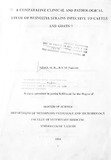| dc.description.abstract | Besnoitia are cyst-forming coccidian protozoa causing besnoitiosis in domestic and wildlife hosts
worldwide. Economic losses result from reduced weight gain and milk yield, meat of poor quality and
skin unsuitable for tanning, long convalescence period and predisposition to secondary infections.
Besnoitia organisms are morphologically identical and closely related antigenically but specific Besnoitia
species have been identified in cattle, horses, antelopes and rodents. Outbreaks of caprine besnoitiosis
have been reported in Kenya but the identity of Besnouia parasites found naturally in goats has not been
clarified. It has been assumed previously that Besnoiiia besnoiti causes natural besnoitiosis in both cattle
and goats. In this study, the relationship between artificial infections of Besnoitia besnoiti of cattle and
Besnoitia sp. of goats was investigated.
Two groups of local goats and New Zealand white rabbits were infected with either of the two parasites
isolated from chronic natural cases of besnoitiosis in the same geographical region. The clinical signs,
haematological and pathological aspects of the disease were studied.
The clinical signs demonstrated biological differences in virulence between the two parasites 111 the
experimental hosts. Bovine Besnoitia besnoiti produced an acute and fatal anasarcous syndrome in goats
and rabbits while caprine Besnoitia sp. elicited a transient febrile reaction in goats and rabbits, and a
chronic form only in goats. While rabbits died within 18 hours following infection with bradyzoiies of
bovine Besnouia besnoiti, they were refractory to the bradyzoites of caprine Besnoitia sp. Haernatological
and histopathological findings revealed different degrees of cellular response but similar patterns of
parasite distribution between the two Besnoitia sp. Total leucocyte cell counts in goats infected with either
isolate produced diphasic leucocytic response curves coinciding with the initial pyrexic and the acute
clinical phases respectively. Viscerotropic Besnoitia cysts were demonstrated in various organs of animals
infected with bovine B. besnoiti and caprine Besnoitia sp. Caprine Besnoitia sp. elicited peculiar
"Besnoitia granulomas" with uniform cellular arrangements in goats.
This study appears to be the first to show that the Besnoitia spp. found in cattle and goats in Kenya
represent distinct strains or biological races of Besnoitia besnoiti. The name Besnoitia granulomae is
proposed for Besnoitia sp. found in goats in Kenya. | en |

